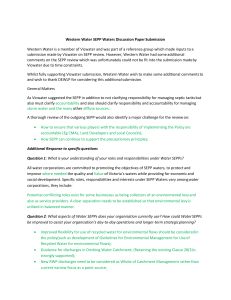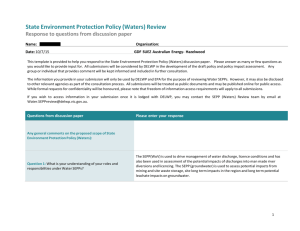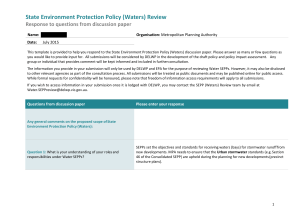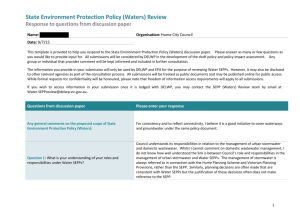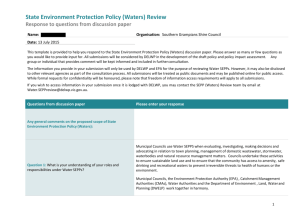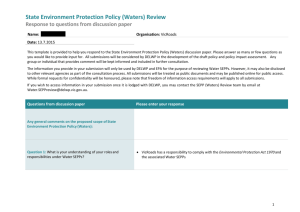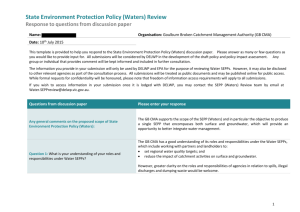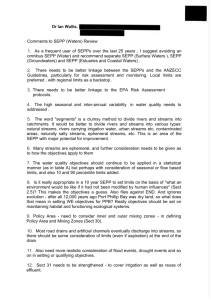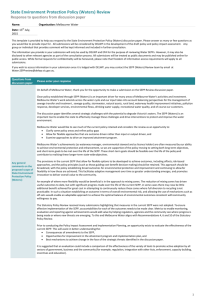Coliban Water (Accessible version) [MS Word Document
advertisement
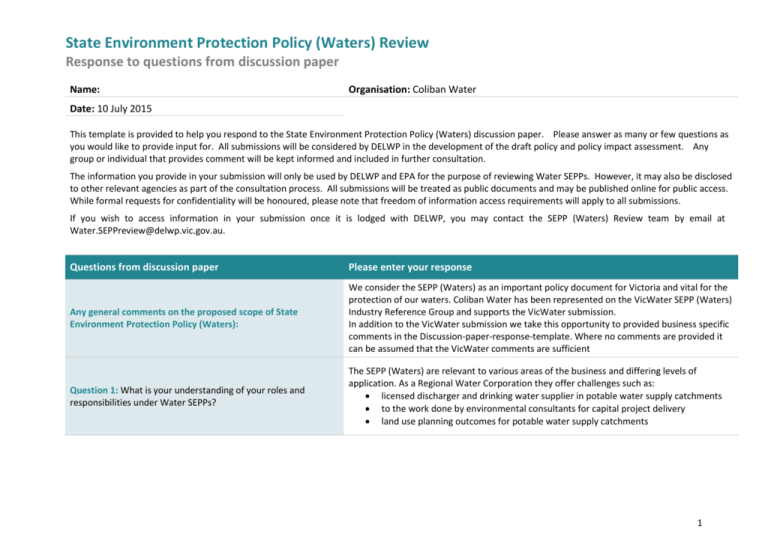
State Environment Protection Policy (Waters) Review Response to questions from discussion paper Name: Organisation: Coliban Water Date: 10 July 2015 This template is provided to help you respond to the State Environment Protection Policy (Waters) discussion paper. Please answer as many or few questions as you would like to provide input for. All submissions will be considered by DELWP in the development of the draft policy and policy impact assessment. Any group or individual that provides comment will be kept informed and included in further consultation. The information you provide in your submission will only be used by DELWP and EPA for the purpose of reviewing Water SEPPs. However, it may also be disclosed to other relevant agencies as part of the consultation process. All submissions will be treated as public documents and may be published online for public access. While formal requests for confidentiality will be honoured, please note that freedom of information access requirements will apply to all submissions. If you wish to access information in your submission once it is lodged with DELWP, you may contact the SEPP (Waters) Review team by email at Water.SEPPreview@delwp.vic.gov.au. Questions from discussion paper Please enter your response Any general comments on the proposed scope of State Environment Protection Policy (Waters): We consider the SEPP (Waters) as an important policy document for Victoria and vital for the protection of our waters. Coliban Water has been represented on the VicWater SEPP (Waters) Industry Reference Group and supports the VicWater submission. In addition to the VicWater submission we take this opportunity to provided business specific comments in the Discussion-paper-response-template. Where no comments are provided it can be assumed that the VicWater comments are sufficient Question 1: What is your understanding of your roles and responsibilities under Water SEPPs? The SEPP (Waters) are relevant to various areas of the business and differing levels of application. As a Regional Water Corporation they offer challenges such as: licensed discharger and drinking water supplier in potable water supply catchments to the work done by environmental consultants for capital project delivery land use planning outcomes for potable water supply catchments 1 State Environment Protection Policy (Waters) Review Response to questions from discussion paper Question 2: What aspects of Water SEPPs does your organisation currently use? How could Water SEPPs be improved to assist your organisation’s day-to-day operations and longer-term strategic planning? The 1-in-5-year rainfall event is used as the design criteria for sizing sewer networks both now and into the future (strategic planning). How this criteria was set in the first place and whether it is still appropriate given predictions on climate change. Significant funds are required to augment sewer assets to cater for future growth so it is important to know that the criteria is appropriate for the risk to the environment. Clarity on the definition of a floodplain would be useful as to how criteria is set and whether it is still appropriate given predictions on climate change. Is the criteria commensurate with the risk on beneficial uses i.e. what dilution factor is appropriate, is this level too high? Question 3: Do you have any concerns about the proposed working title of State Environment Protection Policy (Waters)? If so, what are they? Question 4: What is the best way to reflect what is feasible versus what is aspirational in the context of a 10-year policy cycle? Question 5: Do you support the proposed SEPP (Waters) objective of “this policy is to protect and improve the quality of Victoria’s waters while providing for economic and social development”? Why? 2 State Environment Protection Policy (Waters) Review Response to questions from discussion paper Question 6: Do you support the need to balance economic and social development with overall protection and improvement of water quality for Victoria’s water environments? Why? Question 7: What are the challenges of balancing economic and social development with protecting and improving water quality? How should we manage the appropriate trade-offs between them? The challenges for pattern of growth and variability are more problematic in an inland environment, with ephemeral conditions and MDBA considerations. We consider there is an opportunity to highlight this variability of water environments for northern regions. Greater connectivity between segments and catchment boundaries may provide this opportunity. Question 8: Do you foresee any problems or opportunities that may arise from creating one consistent SEPP to apply to all Victorian waters? Are there other options for streamlining the policies that we should consider? Question 9: Are there any specific types of water environments, for example, a wastewater treatment lagoon, where you think beneficial uses should not be protected? Question 10: Do you think the current measures for classifying surface water and groundwater segments are still appropriate? Are there other measures that should be explored? Wastewater treatment lagoons can be biodiversity hot spots across a severely altered landscape. Environmental values in this case can be managed within an operational regime. While a challenging topic, there is a need for some recognition of the Environmental values that are added, however there needs to be an overriding trigger accounting for the primary reason for the waters existence i.e. wastewater treatment. In applying the SEPPs to planning schemes, and their function as a consideration to development proposals, the segments offer little guidance. Greater recognition of catchment boundaries and the use of ISC to measure any success of the SEPP over its life span could offer better attainment of the objectives of the SEPP. 3 State Environment Protection Policy (Waters) Review Response to questions from discussion paper Question 11: Are there any problems with the spatial arrangements or segment boundaries in the existing Water SEPPs? If so, what are they? See Q10 Question 12: What do you think are the advantages or problems with the new approach to segments and sub-segments? Question 13: Are there any features of the landscape that you would like to see as a standalone segment or sub-segment? Identification of declared water supply catchments would provide an opportunity to consider more specific inland water issues, in the same way that coastal environments are considered. Question 14: Do you believe that all beneficial uses set out in Table 2 of the discussion paper should still be protected under the new SEPP (Waters)? Where do you think a beneficial use would not apply? Why? The beneficial use statement should remain as: “human consumption after appropriate treatment”, as “appropriate treatment” could relate to as little, or as much, treatment as is needed to make the water safe to drink. Question 15: What method or approach could be used to apply the beneficial uses to segments and sub-segments? Beneficial Uses could possibly be clearer if they were set out in a hierarchal order, based on public health outcomes. It may also be of use to separate the uses into Human and Ecological streams, to highlight the different values trying to be attained. 4 State Environment Protection Policy (Waters) Review Response to questions from discussion paper Question 16: Are there any additional beneficial uses that you believe should be protected? Are there any that you think should no longer be protected? Why? Question 17: What do you think about the current indicators, the approach for deriving objectives and the proposed changes? Question 18: How have nutrient load targets been useful in driving environmental investment outcomes? Would you like to see a different approach, and if so, what might that be? Offsets for nutrient loads from WRP discharges can have multiple environmental benefits e.g. revegetation/erosion control works/riparian zone fencing etc. They can also be more cost effective. Load based limits could be considered and be dependent on the variability in quality of the upstream environment. Strong and supportive language regarding water quality/environmental offsets in the SEPP would potentially support better outcomes. Question 19: What is the preferred method for management of at-risk areas? Are there activities that need greater intervention or regulation? What would the intervention be, for example, voluntary or mandatory codes of practice, regulation via licensing? Question 20: What do you think the role of SEPP (Waters) should be in identifying and filling knowledge gaps over the life of the policy? How can we assure an adaptive approach within SEPP (Waters)? Greater recognition of the impact of climate variability/change on discharge regimes for inland environments. Important to create link between surface waters and groundwater in SEPP (Waters), and how discharges to the environment impact or benefit waters. SEPP (Waters) needs to be easily interpreted and applied. 5 State Environment Protection Policy (Waters) Review Response to questions from discussion paper Any other information you would like to share: Clause 13 ‘General responsibility for implementing the Policy’ currently states the Policy will be implemented on a regional basis through regional catchment strategies (RCS). The implementation process needs to be based on broader engagement, as current RCS have missed this function. The use of the State Planning Policy Framework possibly provides a more effective and inclusive vehicle to implement and meet attainment goals. 6
